Chapter 1: Start in Bulgaria
Sofia, 20 October 2016. It’s the start of a long trip to India – in our Opel Rekord E 2.0 S. First, we spend a little time touring around Bulgaria, just to figure out if there were any kinks in the repairs that were made to our Opel. We also take it as an opportunity to bid our farewells to our relatives. They are not particularly happy that Sabina will be giving birth to our first child in India and that we are planning to make the journey in our old model 1979 car! They do not really believe us. Once, Sabina’s mother asked what we’ll eat on our trip. As Sabina answers with the fact that we have enough potatoes and bell peppers with us already, and even a small gas stove to warm up food from the trail, Sabina’s mother returns with consternation, “In the airplane?” “No, Mom. We’re traveling by car,” Sabina answers impatiently. “Really? I hadn’t really picked up on that yet.”
The Opel Rekord was in a terrible state when I got it. I had the help of a few people who still had a few spare parts, and we got it running again. It was difficult to find someone who was willing to give it a go. Finally I found Teo, who knows his way around these kinds of cars. He even tried to talk me out of doing everything in the beginning. We chatted in his garage for an hour before his wife walked in and said to him, “Teo, why won’t you accept this customer’s money? Look at him, he loves his car. So, can you repair it or not?” And that’s how our friendship began. He only allowed me to have my car back once he had made all the repairs to it like he wanted. And this is when our fixation with the India trip in our old Opel Rekord started to take shape.
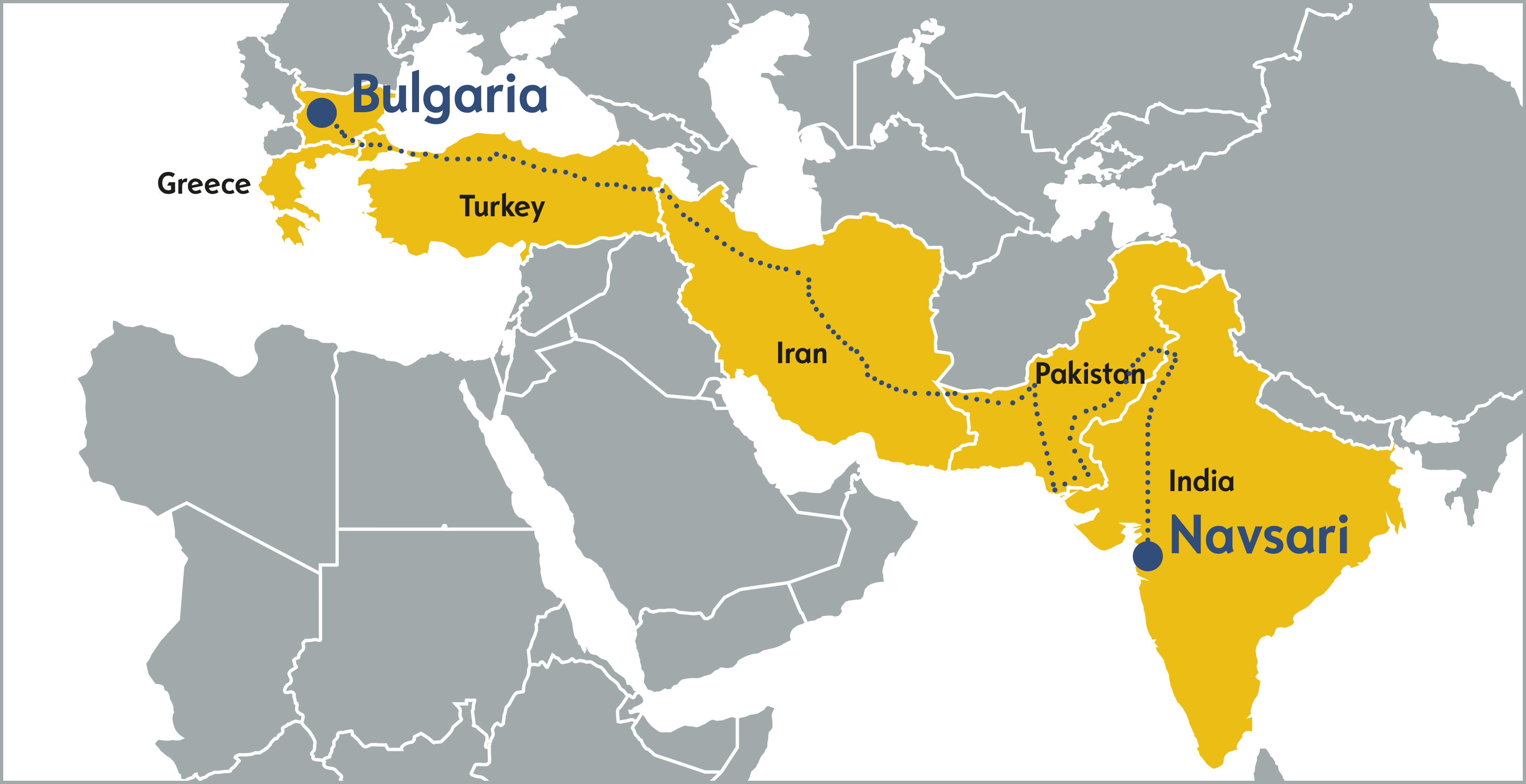
The itinary: Traveling through six countries on two continents in an Opel, without breaking down.
Many might be asking themselves, why India? Of all places? And why embark on a journey when your first child is on its way? And why by car? Much less in an old Opel? We love India, although we know that the people there can get under your skin at times. Especially when they are driving. We have had the idea of driving to India for a long time. It was an anticipated coincidence that our first child would be born there. We quit our jobs in Germany and terminated the lease for our apartment in Gauting, which is near Munich, in April 2016. Our child could hardly wait for us to arrive in India. By the time we left, Sabina was seven months pregnant.
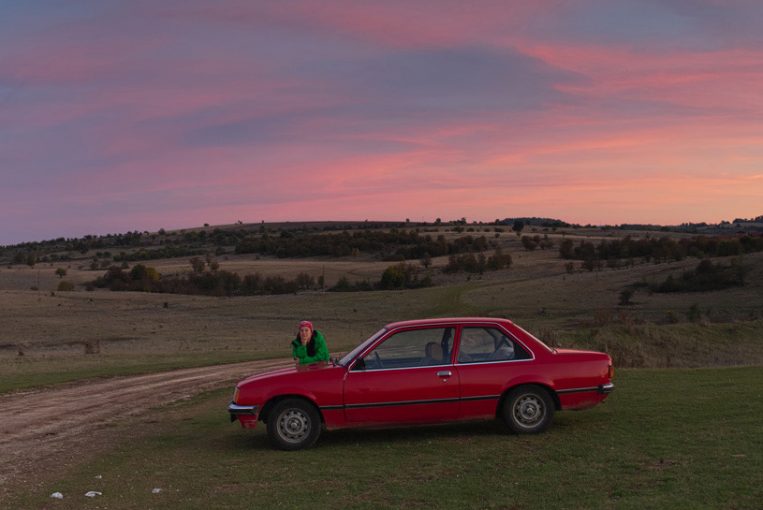
Bidding our farewells in Bulgaria, and the excitement was building.
We finally leave on 27 October to splendid sunshine. Our idea for the first day is to cross into Turkey the less traveled roads entering from Greece rather than the main border crossing with Bulgaria and then spend the night somewhere between Edirne and Istanbul. We cross the first border at Ivaylovgrad into Greece – child’s play. The Greek border officers check various parts of our luggage, which was a lot. When they spy our supply of potatoes in the trunk, they ask us where we are heading. They hear our reply and pause for a moment before letting us pass.
Potatoes in the trunk
The trip through Greece is brief. We arrive at the Greek–Turkish border crossing near Kastanies, approximately 40 kilometers down the road. The officer inspects our papers again and he asks us where we are heading. He can hardly believe his eyes when he sees the extent of our luggage. “We don’t have the time to check it all,” he says. He seriously expects us to return to Svilengrad, which lies behind the Greek–Bulgarian border! The officers there do not believe that we will make it all the way to India when they have inspected our car. Right now, we do not think it will happen either. We did not make it 20 kilometers past the Turkish border today. They finally allow us to continue our journey. We arrive at the outskirts of Edirne by sundown.
Chapter 2: From Turkey to Iran
We drive through Istanbul at a snail’s pace the next day. There is nothing but log-jammed traffic, and we only could manage 50 kilometers in five hours! We arrive at Hereke by the end of the day and pitch our tent in a park along the sea. The Opel Rekord hums along like a sewing machine on the new roads of Turkey. We take the D100, which should bring us to Doğubeyazıt on the Iranian border. After we pass Bolu, the road climbs to an attitude of 1,000 meters above sea level, where it stays until we reach Iran. It’s ideal weather for camping. The sun plays hide-and-seek with the clouds and the wind blows gently, bringing a light rain with it. The valleys are deep, the cliffs high, a river flows broadly flanked by poplars, which are decked out in fall colors already. We camp out near the edge of villages on our way. Everyone we meet is very generous and friendly.
Mr. Haji Emin opens his doors to us
It takes six days to drive across Turkey. We started to have some minor issues with our car on the fifth day, but we managed to deal with them on the spot. At the end of the fifth day we take a right off the main street just outside of Horasan and head down a gravel road. A few kilometers later the road directs us to a village engulfed by barren hills. We arrive at Yarboğaz, where several bearded men bask on the setting sun. We ask one of them whether it would be possible to pitch our tent in a nearby yard. The man speaks only Kurdish, so he calls for ‘Haji Emin.’ This Mr. Haji Emin appears in the doorway of the house to which the yard belongs. The mustached man with bristly hair replies that he would not mind if we pitched our tent in his yard. I ask if my wife could use his bathroom, and he assents. Not before long, we’re sitting in his home, enjoying tea. And shortly afterward, a few snacks appear, followed by a light supper of traditional pita bread rounds, yoghurt sauce, and roasted potatoes. He later invites us to spend a night in his guestroom, a room with comfortable couches, thick rugs, and cabinets, adorned by pictures on the wall depicting his pilgrimage to Mecca.
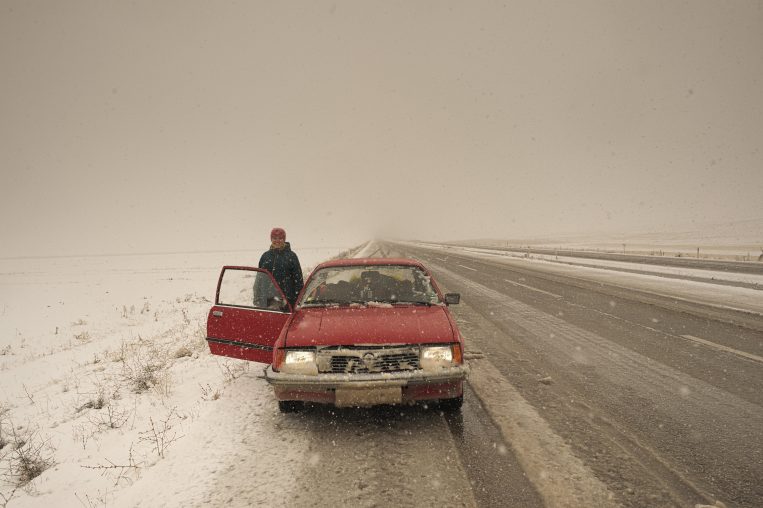
The snow we dreaded caught up with us in the next morning after Haji Emin’s village, we still have to more 2000+ passes to climb.
We are lucky to not have spent a night in our tent. Haji Emin’s guestroom was nicer than a snow-covered tent the following morning. Everything in Yarboğaz is covered with a white coating the next morning. Last night’s rain had turned into snow during the night. Up until now, we had managed to stay ahead of the snow front. Now it caught up to us shortly before the Iranian border. We have snow to look forward to today, because it continues to snow. We climb to 2,000+ meters between Yarboğaz and Doğubeyazıt in our Opel. Our biggest challenges are staying on the tracks carved by the numerous trucks in the wet snow and dodging the sheets of ice slipping from their canvas coverings. We see many cars in the oncoming lane, struggling through the snow, some even without success. We finally arrive at Doğubeyazıt, where visibility is so poor that we cannot even see Greater Ararat, whose peak juts 5,000+ meters above sea level. There’s nothing but confusion to greet us at the Turkish-Iranian border. Initially they cannot tell us where to proceed and what to do once there. A Turkish border officer walks us through the formalities, which are far more complicated on the Iranian side. However, we manage to find a resourceful and helpful man who pulls us through all the inspections in just 15 minutes – for a fee of 20 Euro.
Chapter 3: Driving through Iran
In the twilight, we arrive at Maku, which is the first town located shortly after the Iranian border crossing. Traffic is chaotic and confusing: wet roads, cars without headlights, people dressed in black crossing the road without looking. The more the evening advances, the more convinced we are to spend our first night in Iran at a hotel. A friend from Iran had once warned us that driving a car in Iran is one hundred times more dangerous than in Italy, and ten times more dangerous than in Turkey. It takes me about a day to figure out how the Iranian car driver thinks. What I eventually discover that needs special attention is their sudden turns. Otherwise Iranians drive hesitantly and with more reservation. It almost appears like they have no idea where they are going. Traffic moves relatively smoothly on the highways of Iran. The cities are more difficult to navigate, even with GPS navigation devices running OSM (Open Street Maps). The OSM maps are neither very accurate nor very up-to-date. We spend the next few nights camping or staying at the homes of the people we meet along the way. Iranians are very welcoming, and it’s a beautiful country, as well. We will definitely return to this country when our child is old enough to travel.
Praise for the starter
Arriving in Karaj nearby Tehran we decide to look for someone to repair our Opel’s starter. The starter sometimes malfunctioned showing no response at the time of ignition and I used to tap it with a hammer to cure it. The problem developed since Turkey, the hammer trick was doing the job but a repair was needed. It turns into one of the most memorable experiences on the trip. The car mechanic at the garage puts out the starter and cleans it. He then proceeds to explain to us how there is no other starter on the market as good as this one. I never used the hammer again, the starter never gave us a single problem on our trip after the cleaning and the praise. From Karaj we move south towards the city of Bam the next 5 days. In the village Hormak we end up to a dead end, even though the GPS was guiding us that we could reach Bam from here, which would have been our destination for the day. We are reluctant to go back and lucky enough we come across a police station where the officers inform us that there is an unpaved road that they would show us. We agree. The police Jeep we follow leads us through a magical landscape in which the hills are alive with hues ranging from rust red to blue. It’s the middle of a desert, but the condition of the road isn’t particularly bad. The trip takes us over gravel terrain in areas, in others, sandy terrain. Our Opel slips and slides a little but sticks to the road, although the engine is put to the test. The heat is not the worst of it, it’s the build-up of dust kicked up by the Jeep in front of us. It’s worth it for the dazzling vistas we receive in return. This route is by far the most fascinating we see on our journey through Iran. We arrive at Bam, a city with a population of 77,000, where we spend the quiet, starry night under a nearly full moon camping in the desert next to the city.
The next day takes us 340 kilometers farther along on our trip. It’s a wonderful asphalt road through the desert until we arrive at Zahedan. We don’t spot any other vehicle in hours. We start to count corpses of camels lying by the side of the road, because there’s basically nothing else to count. The full moon glows brightly in the twilight as we approach Zahedan. The city counts 560,000 inhabitants and is infamous for crime, drugs, and money laundering. It lies in close proximity to the border to Pakistan. We appreciate the fact that we have friends who live here and we can stay with. We rest up and stock up to ready ourselves for the journey through Pakistan. Iran didn’t have any real surprises in store for us, but things will soon change.
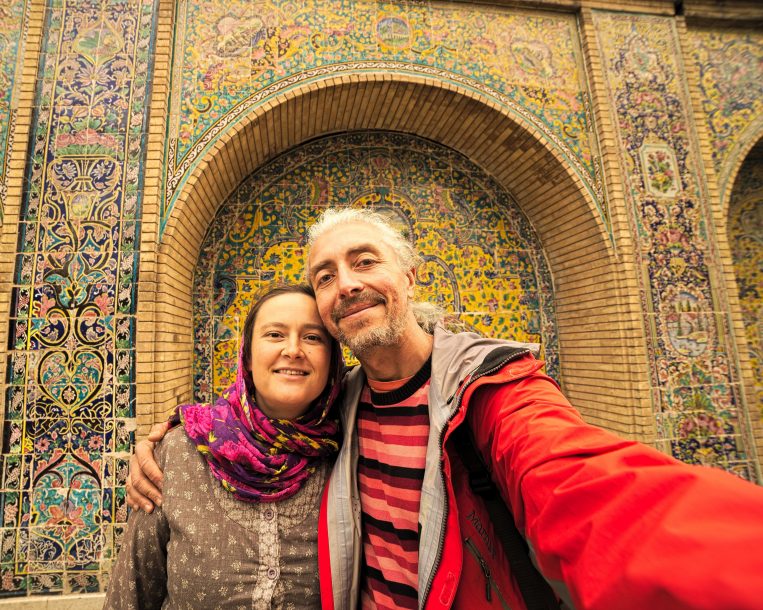
Selfie with Sabina und Vladimir Harizanov, Golestan Palace, Tehran.
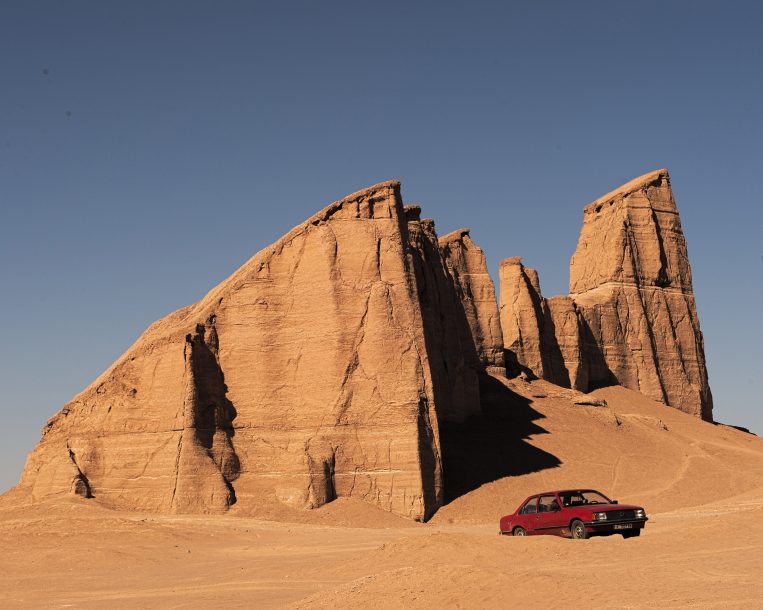
It would be an insult to call this cenery just a backdrop.
Chapter 4: Police escort through Balochistan
There is a police checkpoint on the road to the Pakistan border after leaving Zahedan. The officers check our passports. We are ushered into a small office with walls littered with anti-American sayings. The officer is not at all pleased about our desire to continue our journey through Pakistan. In the end, he relinquishes and we are allowed to go. We stop at a gas station to fill up the Opel Rekord to the brim in Mirjaveh, a border town. When we’re finished, we are told to follow a military vehicle laden with heavily armed soldiers to the border crossing. There they inspect our documents and our Opel before they eventually allow us to continue. We cross the border and now on Pakistani side we are handed over again to security officers. We spend several hopeless hours at several different barracks with several hapless border patrol officers. We follow a border guard who leads us on a motorcycle to a military outpost a few kilometers away. It is completely surrounded by a high wall and barbed wire. We are told to pass through the metal gate. The guard informs us in simple English that we are to stay there. A little shy, even. “You drive tomorrow.” I return, with a slight irritation in my voice, “Why tomorrow? It is only two thirty. Why we do need to wait here?” “You will be escorted to Dalbandin tomorrow. You are not allowed to travel through Balochistan unaccompanied.”
I park our car at the outpost at the end of a long row of rusting vehicles. The commander allows us to use his office and instructs us to not leave it. It becomes clear to me: This is not a normal outpost. It is a jail with cells that can be locked, two offices, and a room for soldiers. We wait.
Luxury meets despair
Suddenly, there’s a bustle of activity around 8 p.m. Several soldiers usher in more than 100 dusty, tired men, some carrying bags or backpacks, others without anything. They are illegal immigrants who were deported from Turkey. They are hungry, so we share a little of our bread with some of them. And we start up a conversation. They are trying to flee Pakistan, and their impoverished lives there. They want to partake in the riches of the Western world. They will only spend a few hours at this transitional outpost before being bussed out to the next outpost. Sad and confused, we lay down to sleep. The West exerts its pull on the East. People on both sides vie for a spot on the other side, meeting here in their journey. For one group, it’s a luxury trip, for the other, it’s an attempt to leave behind a life in deep despair.
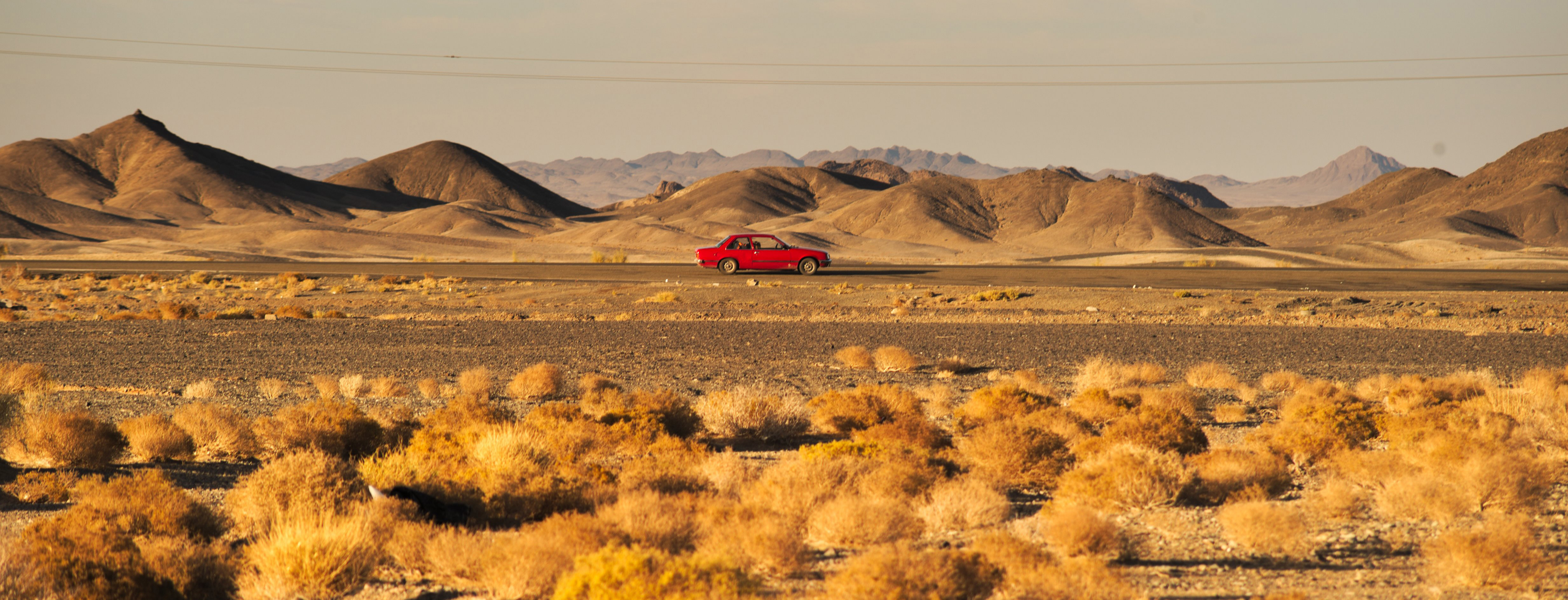
On the road from Bam to Zahedan, it becomes clear: Deserts are not entirely barren wastelands
We are only permitted to move around with a security patrol since Taftan, the first city in Pakistan just behind the border. The Pakistani government is doing great job, tremendous job because all tourists are escorted through Balochistan. We follow a patrol car during the day normally. Every 30 to 50 kilometers, our escorts are spelled out. We wait until the next ones are ready in order to embark on the next stage of the trip. We lose valuable time in the process. We manage to arrive at Dalbandin the first day, where we are brought to a hotel, which we are not allowed to leave.
The Opel Caravan continues its journey
Our Opel caravan strikes out for Quetta the next day in order to receive our No Objection Certificate from the authorities. We need it to be permitted to leave Balochistan again. The certificate also indicates the route we need to follow: the shortest one through Balochistan via Jacobabad and Shikarpur. However, the police escort takes us on a route that actually passes through Kudzar. It may be the most direct route to arrive at Karachi, but it means that we have to remain with our escorts in Balochistan for two more days. Having an escort is a unique experience. It was one we had never had before. The downside is that we could not camp anywhere.
We manage to pass Kudzar before we stop on the first day. The security forces remain with us the entire time while we drive, yet they keep a certain safety distance. At times we don’t see them for several hours. I check the rearview mirror around four thirty and realize that the LEVIS Jeep is nowhere in sight, and by now I’d recognize it pretty easily. I tell my wife that we should risk it and pitch our tent somewhere. She agrees. We pull off on an unpaved road and drive to the outskirts of a small village to scout out the area for our campsite. Before long, maybe a half hour, the LEVIS Jeep appears. We’re surrounded by soldiers, and their message is unmistakable: Return to Kudzar. No discussions. When we arrive at Kudzar, we are taken to an unbelievably fancy building where we are expected to spend the night. To our surprise, the place is better than any hotel we have ever stayed at. There is hot water. The beds are comfortable and there is even a flatscreen TV! We’re here at the request of our escort, the man behind the wheel of the LEVIS Jeep, the Pakistani government, and the other security forces. Now that’s hospitality!
Chapter 5: Welcome to India!
We’re on our own once we have left Balochistan behind us. Our journey will now take us to Karachi. With a population of an amazing 13 million people, it’s the largest city in Pakistan. From there, we head toward Hyderabad, which boasts a population of ‘only’ 3.5 million. As the fastest growing city, it is also the third most populous city in the country. We pay a visit to the Indus river the next morning before driving to Lahore. There are countless trucks transporting large containers on the roads here. We were told that we are only required to have an escort in Balochistan. But now in Sindh, we have a police escort trailing us again, all arranged by a police officer at whose house we spent last night, in a village near Hyderabad. The new police escort takes us out of Sindh and we are on our own. We’re in Pakistan for another two nights. We set up our tent on schoolyards in villages in Punjab. We stroll through the fields of roses and sugarcane during the day, making new friends all the time. Just before the border between Pakistan and India, we get lost. Luckily, we arrive at the crossing on time, which means one hour before it would normally be closed. They let us pass with little ado.
We’ve made it! India! We don’t waste a second with celebrating and start off on our goal of reaching Navsari. We have friends who live there. Fortunately, up until now, we have not had one single serious accident.
Driver’s education crash course
Our old Opel Rekord was purring like a kitten back then. And it still is to this day. I hope to take it back to Bulgaria by myself, or maybe together with a friend, and then visit a few of the places off the beaten path that we didn’t manage to see this time. But now we are returning to Bulgaria – this time by plane, and we’re not alone anymore. Our daughter Samira is joining us on the flight. She was born on 10 January 2017, while we were in Navsari! It was a fascinating trip through countries you’d rarely visit. And we’d consider it a driver’s education crash course, but where everything was different than you would expect. Between Turkey and India, I learned how to adapt to bad driving.
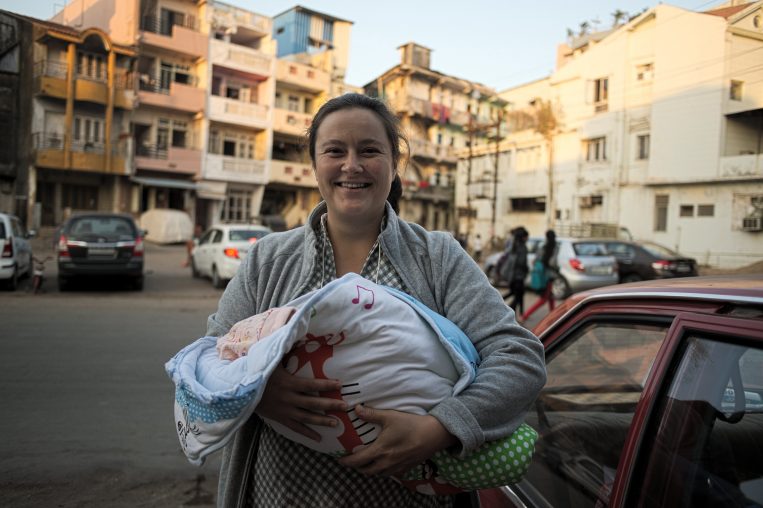
Fait Accompli – journey complete, and Samira is here!
We made it!
We are actually in India!
Text und photos: Vladimir Harizanov
Vladimir Harizanov was born in 1971 in Kardzhali, a town in the south of Bulgaria. He studied electrical engineering in Sofia and traveled the world. With his wife Sabina who is trained as a psychologist, he lived in Bamberg, Thüringen and near Munich. In 2016 both decided to change their lives and to go to India as volunteers. Ten years ago, Vladimir had traveled from Bulgaria to India by bicycle. He documented his trip in an eBook entitled ‘Eastwards, towards India at 15 km/h.’ And he plans to write another book and put together a slight show about the latest trip to India. Please find further photographs from Vladimir Harizanov here.